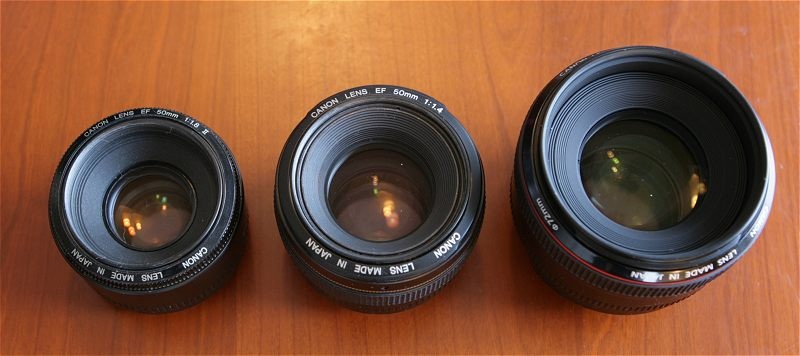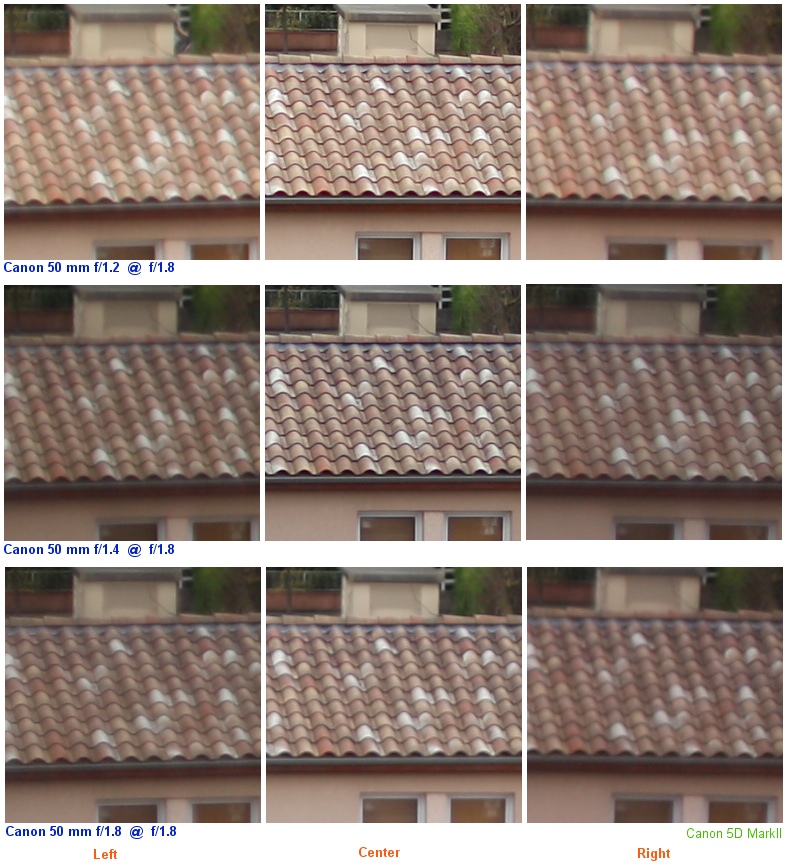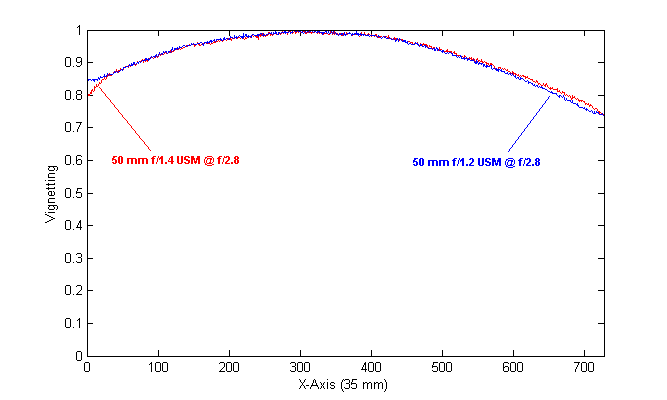Version française
COMPARISON
OF
50 mm 1:1.8 II, 50 mm 1:1.4, and 50 mm 1:1.2 L CANON LENSES
This test compare the sharpness of 50 mm lenses manufactured by Canon. These lenses have different relative apertures (1.8, 1.4, and 1.2) and various prices (the 50 mm f/1.2 L Series being far more costly).

From left to right: 50 mm f/1.8 Mark II, 50 mm f/1.4, and 50
mm f/1.2 Series L.
DAYLIGHT SHOTS
5D DSRL
All lenses are attached to the same camera, ie. a Canon EOS 5D (first version). The focus is done at the center of the field.

|
50 mm f/1.8 |
|
|
|
|
50 mm f/1.4 |
|
|
|
|
50 mm f/1.2 |
|
|
|
|
50 mm f/1.8 |
|
|
|
|
50 mm f/1.4 |
|
|
|
|
50 mm f/1.2 |
|
|
|
|
50 mm f/1.8 |
|
|
|
|
50 mm f/1.4 |
|
|
|
|
50 mm f/1.2 |
|
|
|
|
50 mm f/1.8 |
|
|
|
|
50 mm f/1.4 |
|
|
|
|
50 mm f/1.2 |
|
|
|
|
50 mm f/1.8 |
|
|
|
|
50 mm f/1.4 |
|
|
|
|
50 mm f/1.2 |
|
|
|
|
50 mm f/1.8 |
|
|
|
|
50 mm f/1.4 |
|
|
|
|
50 mm f/1.2 |
|
|
|
DAYLIGHT SHOTS
5D
Mark II DSRL

POINT LIKE SOURCE TEST
We chose a far away row of street lights located length wise in the field of view. This will clearly show optical aberrations in a synthetic and non-subjective way. With a point source it is indeed easy to locate issues such as spherical aberration, astisgmatism, coma, mounting problems (off-centering).... The lateral and axial chromatic aberration can also be assessed but we only carried out a partial analysis because the sources selected did not have a rich spectrum (high-pressure sodium vapor lamps). Note that the response we see can be regarded as the Fourier transform, the FTM, (and conversely) but with the advantage of an intuitive 2D vision.
We chose not to rely on the AF system of the camera which is not accurate enough. Focusing is performed manually by carrying out many iterations. Focus is reached at the center of the field of view without taking into account the edges of the image.
The camera was installed on a solid tripod and we used a remote control. Images are in JPEG format with the minimum compression.
The following image shows the target field: a far away row of street lights. Three areas are partially detailed (yellow squares) at the center and on the extreme edges of the Canon 5D (first version) 24x36 sensor.

The following images show the result (100% scale) for various apertures (sometimes the measure is Not Applicable (NA) when the corresponding aperture is not available).
|
CANON 50 mm f/1.8 |
|
|
|
|
CANON 50 mm f/1.4 |
|
|
|
|
CANON 50 mm f/1.2 |
|
|
|
|
CANON 50 mm f/1.8 |
|
|
|
|
CANON 50 mm f/1.4 |
|
|
|
|
CANON 50 mm f/1.2 |
|
|
|
|
CANON 50 mm f/1.8 |
|
|
|
|
CANON 50 mm f/1.4 |
|
|
|
|
CANON 50 mm f/1.2 |
|
|
|
|
CANON 50 mm f/1.8 |
|
|
|
|
CANON 50 mm f/1.4 |
|
|
|
|
CANON 50 mm f/1.2 |
|
|
|
|
CANON 50 mm f/1.8 |
|
|
|
|
CANON 50 mm f/1.4 |
|
|
|
|
CANON 50 mm f/1.2 |
|
|
|
|
CANON 50 mm f/1.8 |
|
|
|
|
CANON 50 mm f/1.4 |
|
|
|
|
CANON 50 mm f/1.2 |
|
|
|
SHARPNESS ON A STAR-FIELD IMAGE
The constellation of Orion is photographed with the Canon 50 mm f/1.2L lens attached to an EOS 350D. The original IR-cut filter is replaced by a special Baader filter for a better transmission of the hydrogen Halpha line. The unit is fixed on a simple tripod. The elementary exposure time is very short (4 seconds) to avoid the rotational movement of the Earth. The observation is made since an urban site, very polluted by the artificial light. The preprocessing, from RAW files, is standard (bias, thermal signal, division by the flat-field corresponding to the aperture, registration and addition).
Below, a global view of the field and the identification of detailed area. The zone observed in bottom left, corresponds to the limit edge of the EOS 350D detector.

Crops (at the original scale):



The image becomes very fine at f/1.8 for the center of the field (the contrast remains correct with higher aperture). At the edge of the field, moderate lateral chromatism is noticed. It should be remembered that ir-cut filter transmission curve is translated toward the red. The bleue glow is the result of the Baader filter modification (the short wavelength curve is significantly shifted toward the UV after the modification - see the transmissions curves here). It is confirmed that even in edge of field, a significant proportion of the signal is concentrated on a small surface.
VIGNETTING
Photometric curves along the horizontal axis of the EOS 5D detector (from RAW files and after removing the electronic bias signal).




|
|
|
Sample shots...

Images
USM 50 mm f/1.2 + Canon EOS 5D
50 mm
f/1.2 @ f/1.2
50
mm f/1.2 @ f/1.4
50
mm f/1.2 @ f/2.0
50
mm f/1.2 @ f/5.6

50
mm f/1.2 @ f/1.2 - 400 ISO - 0.5 second. Canon EOS 5D.

Canon
50 mm f/1.2 stopped at f/1.8 + Canon EOS 350D modified Baader (extended red
response) at 400 ISO.
The setup is fixed on a tripod (no equatorial mount).
Stack of 30 x 4 seconds frames (2 minutes exposure). Crop of the center field.
The
Barnard's loop is faintly visible.